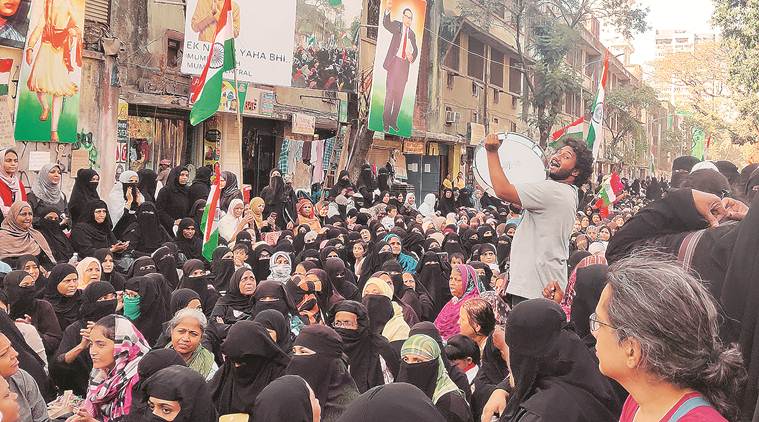 Bappadittya Sarkar in Mumbai. (Photo: Tabassum Barnagarwala)
Bappadittya Sarkar in Mumbai. (Photo: Tabassum Barnagarwala)
For their performance of The Rapist is You, a Chilean protest song that condemns sexual violence, at Mumbai Bagh on Friday, a group of artistes carried a big thaal and a serving spoon as musical accompaniments. Sapan Saran, who directed the performance, had realised that the police were not permitting musical instruments. The piece directed by Saran was set to beats, and she had to find a solution. The loud clanking of utensils along with the sound created by the artistes, and small instruments such as the manjira they had managed to sneak in gave the performance a raw energy.
As the protests against the Citizenship Amendment Act show no sign of ending, musical instruments, especially those associated with folk and street performances, have suddenly become objects of suspicion in the eyes of the police and others against the protests.
On the day Saran was scoping out Mumbai Bagh for their performance, a Jaipur-based musician-poet, Bappadittya Sarkar, had been disallowed by the Mumbai police from carrying his dafli to a protest site. The night before, an Uber driver had taken him to the police, based on his phone conversation about anti-CAA protests, and the round musical instrument he was carrying.
“Anytime an instrument is played, it indicates cultural activity. It also mobilises people in a certain way. The state is scared of that. In Maharashtra, instruments such as dimdi, tutari and daf are often used by lokshahirs. Hence, they are considered to be people’s instruments. To take them away is like taking away their voice,” says Saran. It is not just the anti-CAA protests. For the opening performance at the Mumbai Pride March recently, Saran’s group was stopped from playing the dhol and dafli on the ground that it was “an area demarcated for sports”. They had to improvise on the spot and create music based on the idea of beatboxing.
Daf and its smaller version, dafli, have always been popular with protestors. “These are quite effective while trying to draw attention. They are also easy to play,” says Madhav Pawar, a veteran film musician. The 23-year-old Sarkar echoes Pawar’s views when he explains how he started performing with a dafli two months ago. “This belonged to a friend. In a poetic way, I’m happy that I inherited it. At the Jaipur Literature Festival last month, a volunteer snatched the dafli from me when we were sloganeering. When I asked why, he told me that the dafli was drawing people’s attention. That increased my fondness for dafli. It has been like a friend and a comrade,” he said.
Unfazed by this, Sarkar taught some women protestors at Mumbai Bagh how to play the dafli before he left on Friday. “The dafli keeps me grounded. Its sound remains constant while the player can keep changing,” adds Sarkar, who was in Mumbai to present his ghazal about the women of Shaheen Bagh at the Kalaghoda Festival.
When asked about restrictions on carrying the dafli and other musical instruments, Abhinash Kumar, Deputy Commissioner of Police, Zone III, Mumbai, says, “When the protest itself is illegal, musicians and artistes should not be going into the site at all.”
Giving a brief history of the daf and its cousins, Mumbai-based musicologist Kushal Gopalka says, “Earlier, it was called ‘chang’ in India. Chang translates into daf which is a big instrument, 24 inches in diameter, while the dafli is smaller. It is also known as dimdi and kanjira, and is widely used in folk music.”
Bollywood, too, knows the power of the dafli. In the ’50s, it became a symbol of criticism against corruption and capitalism when in Shree 420, Raj Kapoor crooned Dil ka haal sune dilwala. It has also been a symbol of celebration when Rishi Kapoor with a dafli in hand sang Ramji ki nikli sawari in Sargam.
Gopalka cites Neha laga ke from Sanyasi (1945) composed by Naushad as one of the earliest instances of a song using the dominant sound of the dafli. Other popular instances are Ab mera kaun sahara in Barasat (1949), Mera naam Raju in Jis Desh Mein Ganga Behti Hai (1960), Raja ki aayegi baarat in Aah (1954) and Aaj phir jeene ki tamanna hai in Guide (1965). “Most top musicians such as Roshan, Naushad, and Shankar-Jaikishan have used the dafli sound. The daf gives a very broad sound and a body to the song,” he says.
Even films in the mould of the new nationalism use the dafli. In the recent Ajay Devgn-starrer Tanhaji, Pawar has played the dafli for the background score in a battle scene. “In cinema, the dafli is used to create a range of moods — from pathos to joy. Dhina dhin dha in Ram Lakhan is considered to be an iconic peppy tune. I have also played the dafli for Nusrat Fateh Ali Khan’s sufi songs and several Rahat Fateh Ali Khan numbers. In Maharashtra, the dafli is used while singing devotional songs,” adds the veteran musician.